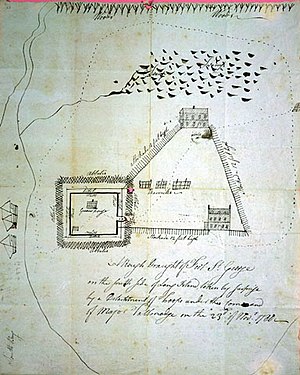Battle of Fort St. George
| Battle of Fort St. George | |||||||
|---|---|---|---|---|---|---|---|
| Part of the American Revolutionary War | |||||||
 Sketch by Benjamin Tallmadge of Fort St. George |
|||||||
|
|||||||
| Belligerents | |||||||
|
|
|
||||||
| Commanders and leaders | |||||||
| Benjamin Tallmadge | |||||||
| Strength | |||||||
| 80 | 61 | ||||||
| Casualties and losses | |||||||
| 1 wounded | 7 killed 54 captured numerous non-combatants also captured |
||||||
The Battle of Fort St. George (or Fort George) was the culmination of a Continental Army raiding expedition led by Benjamin Tallmadge against a fortified Loyalist outpost and storage depot at the Manor St. George on the south coast of Long Island on November 23, 1780, during the American Revolutionary War. Tallmadge's raid was successful; the garrison was surprised, and many provisions and prisoners were taken.
Loyalist refugees from Rhode Island were resettled onto Long Island after the British withdrew their forces from Newport, Rhode Island in 1779. Some of these were established at Manor St. George on the southwestern part of the island (in present-day Mastic Beach, New York). They fortified the property, erecting a 12 feet (3.7 m) high in a roughly triangular shape around the manor house. The stockade was lined with abatis (tree branches with sharpened points facing out) and a deep ditch.
Major Benjamin Tallmadge led a force of about 80 men (drawn from his 2nd Continental Light Dragoons) that crossed Long Island Sound in whaleboats from Fairfield, Connecticut on November 21, 1780, landing at present-day Mt. Sinai. Leaving a guard of 20 men with the boats, the remaining men began to march across Long Island that evening, but bad weather forced them to return to the boats. After the weather improved, Tallmadge again set out on the evening of the 22nd, arriving near the property before dawn on the 23rd.
...
Wikipedia
